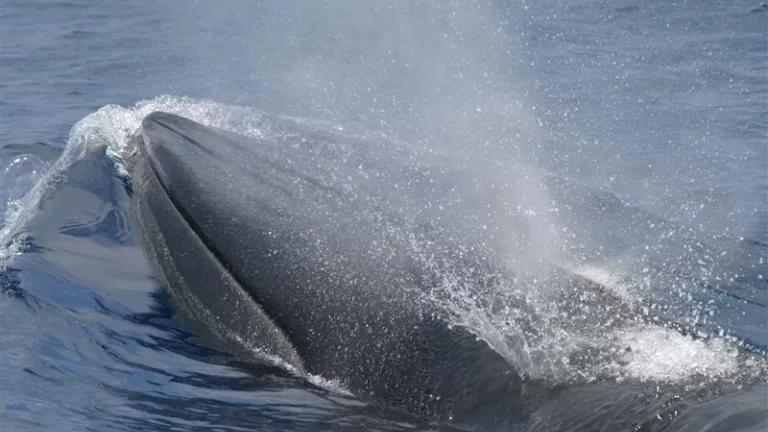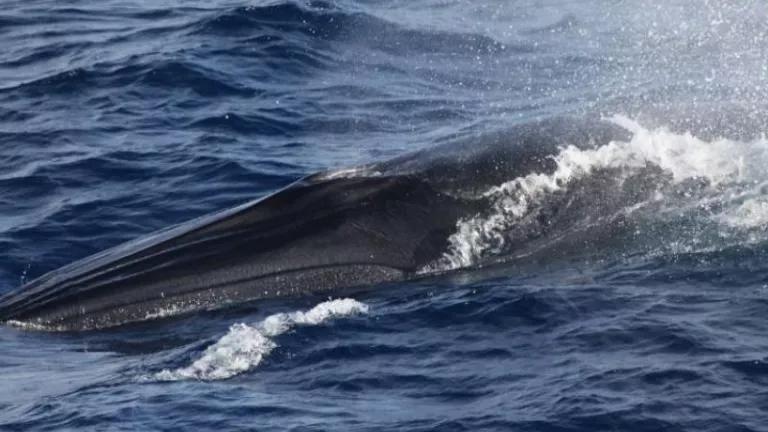
A Gulf of Mexico whale swimming in the Gulf of Mexico
Wayne Hoggard/NOAA
This is the first installment of the Gulf Whale Artist Series, highlighting local artists who are raising awareness about the magnificent and critically endangered Gulf of Mexico (Rice’s) whale. Stay tuned for future spotlights on various artists, including muralists, filmmakers, and painters.
Reverie for the Baleen of the Gulf of Mexico of Many and No Known Names (Starts at 1:08:05)
New Orleans-based composer Cory Diane is a recent graduate from Tulane University with an M.A. in Music Composition, where their work centers on the ecological complexity and vibrancy of the Gulf of Mexico. In their contemporary electroacoustic piece “Reverie for the Baleen of the Gulf of Mexico of Many and No Known Names,” Diane uses degraded ocean soundscapes and Rice’s whale songs to convey the haunting reality of the threats faced by these animals. With NRDC’s Lexi Nutkiewicz, Diane discusses the inspiration behind the composition, their creative process, and the broader social impact of their work. This interview has been edited for length.
Lexi Nutkiewicz: Tell me about yourself and how you got into music.
Cory Diane: I’ve been a musician most of my life. I started spending time in New Orleans after Katrina as a volunteer, and then eventually moved here. It’s one of the most musical cities in the world and a place where music is integrated into all different parts and components of life— spiritual practice, community, celebration, culture, and ritual. I like making music because it moves me, and I try to have a musical practice that is connected to the social movements that are important to me.
Give us some backstory – how did you become interested in whales and marine life, in general?
CD: I was on a little trip and seeing the Pacific for the first time, and there was news of another mass die-off of ocean life. I was seeing walruses and while I was looking at them, the news was heavy in my mind. I was like, “I need to make some music about mass extinction!”
More recently, I started hearing about Rice’s whales and became captivated with their story. One of the reasons I call my composition “The Baleen of the Gulf of Mexico of Many and No Known Names” is to reflect on their journey from obscurity to recognition and perhaps prominence in the popular imagination. They’ve held many names and been referred to in all these different ways! And as I just started to become interested in the whales, I learned that one of the major threats they face is anthropogenic sound [from oil and gas surveys]. As a musician, the intersection with sound interested me. And it’s a very Gulf Coast story, the way that they’re threatened by extractive economies.
I appreciate your mentioning how Rice’s whale has been called so many names. Given that this species is just starting to have unique recognition, what would you name it in a perfect world?
CD: I'm also interested in Indigenous names for these whales, as I believe people have been in relationship to these whales since long before Dale Rice. I reached out to some friends, Joseph and Jeffrey Darensbourg, to offer some possibilities.
There’s a Choctaw word that means “great, big fish”: “Nani Chitto.” And then an Ishakoy word which means “big, powerful fish”: “Yam Hiwew.” I’m curious to learn more possible names from languages across the Gulf and Caribbean, places where there have long been "unconfirmed baleen sightings."
But I am in such adoration and have so much respect for the scientists who have been some of the first advocates. It’s a long story of advocacy within science that is a really big piece of the story that’s gotten these species to recognition.
One thing that instantly drew me to your piece on the whale is its very haunting sound. How would you describe this piece to listeners?
CD: I’ve been referring to the piece as a love song to the Rice’s whale. It’s an immersive exploration of the soundscape of the Gulf of Mexico and the repertoire of the whale as it calls. Sound emanates from the piano but it’s also picked up live from a microphone and then circulated around the audience. And this is paired with underwater sounds from the Gulf of Mexico and samples of Rice’s whale songs obtained from NOAA.
The piece is in two movements, and has been developed through close collaboration with Clementine Harman and Peter J. Bowling. We’re currently playing it as a trio. The first movement is an exploration of anthropogenic soundscapes, starting with an emulation of ocean waves, played by gingerly sweeping paper across the horizontal strings of the piano. Then we use the friction mallets along the length of these strings to create these long, haunting sweeps. These sounds are put in a loop, and the loop is moving and building. Then we start using bows; the bow hairs create these ambient washing sounds. The idea here is to play with ethereal beauty and create this bed of sound that really demonstrates a muddying of sonic space with perplexing, otherworldly sounds.
But from the very beginning, there’s also a slight thread of seismic [oil and gas] surveys, and that’s because in any recording of the Gulf of Mexico, for the most part, the sound of seismic surveys is there, be it as a foreground or a background presence. And the movement culminates with Clementine going underneath the body of the piano and banging the bottom of the piano with a timpani mallet every 10 to 15 seconds, increasing in speed. It’s a crescendo of seismic survey activity, and that’s happening below and above the piano.
So the piano becomes this amazing performance and storytelling device for anthropogenic sound in the ocean. It’s really physical, it’s really visual, it’s sonically really compelling and immersive because it’s all around the audience. And it results in this tension where generally everyone needs it to stop.
It also speaks to the experience of the whales because, for humans, we can put in earplugs or remove ourselves from loud situations, if possible. But for whales, they’re essentially stuck underwater. Let’s talk more about the second movement.
CD: The second movement of the piece is about uplifting the songs and repertoire of the Rice’s whale. Part of my fascination with these whales is the various roles that sound has played in their journey from obscurity to recognition for conservation. We still don’t have a wealth of photos or videos of Rice’s whale, but we have a wealth of their songs from passive acoustic monitoring. Passive acoustic monitoring has been such a resource to science and specifically to advocating for these whales, and creating energy within the scientific community to further pursue a hypothesis that they could be a species.
In the second movement, the piano itself is a whale. The most common sound the whales make is what’s called the “long moan”; it lasts for 10 to 30 seconds, then it swoops downward—and we can do that on the body of the piano with a friction mallet. We start by playing the whales’ songs on the piano, and then begin incorporating actual recordings of them in surround sound around the audience, and the whole idea is these sounds dance together. The piece ends with Clementine going back under the piano and the coordination of downward pulses.
It’s really a storytelling piece about these whales, their song, and kind of the precarious place they have in the Gulf—their home.
What’s the reaction been to the piece?
CD: I’m really grateful and surprised that it resonates with people so well. I feel like more people in New Orleans know more about the Rice’s whale than they did a year ago.
There’s an organization in town called the Neighborhood Story Project and their director has been to a couple of performances of this piece and was really moved. She’s commissioning me to work with her and develop an education poster for the Rice’s whale for schools and community centers. Her organization is a storytelling project about New Orleans communities, just like we need to be a better neighbor to these whales.
We talk about the impact with local and regional communities because the whale is only in the northern Gulf, and it’s so important to have the community support because it’s almost a symbol of the communities.
CD: It’s about awareness. The piece is a way that people can learn about the Rice’s whale and develop an emotional connection with them. It’s also about developing an understanding of the industrial practices that have a relationship to the whales. Communities are dealing with the effects of extractive economies from Cancer Alley in Louisiana to Rice’s whales in the Gulf. It’s important to draw out these interspecies connections from a loving, emotional, and intellectual place.
I loved that you touched on the environmental justice aspects of it because when we talk about environmental justice, it’s a very person-centered perspective, but I think there are ways to consider a kind of environmental justice for animals. I think you explain it in such a beautiful way, so thank you for that.
CD: Well, it’s about people developing connections with the whales and seeing the connectivity between these issues and these communities. I think it’s so wonderful that the whales have been recognized as a species—and they are deserving of being recognized. They’re also inherently deserving of life, like we all are. They’re deserving of their sonic space, like we all are. They’re deserving of the space to make music, like we are. Whales also use songs for culture and pleasure, not just navigation or communication. They have a right to culture, they have a right to pleasure, they have a right to play. These extractive economies threaten beauty in life from every angle—an oil spill, a pipeline being laid, Indigenous lands being taken, the sonic space.
To follow Diane’s work, you can follow them on Instagram @savorypancakes.




